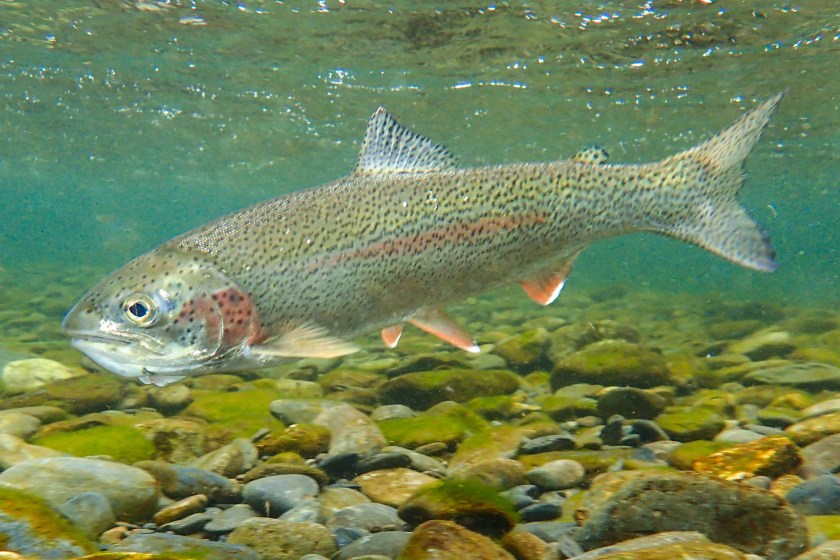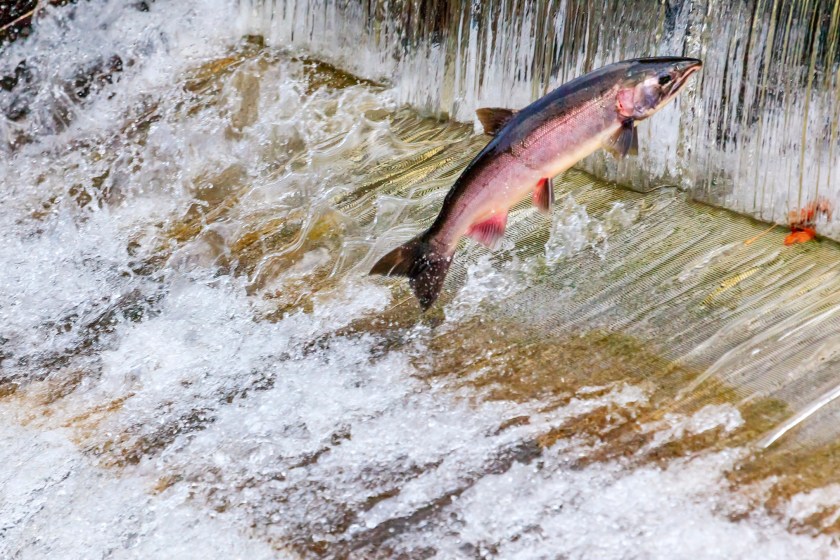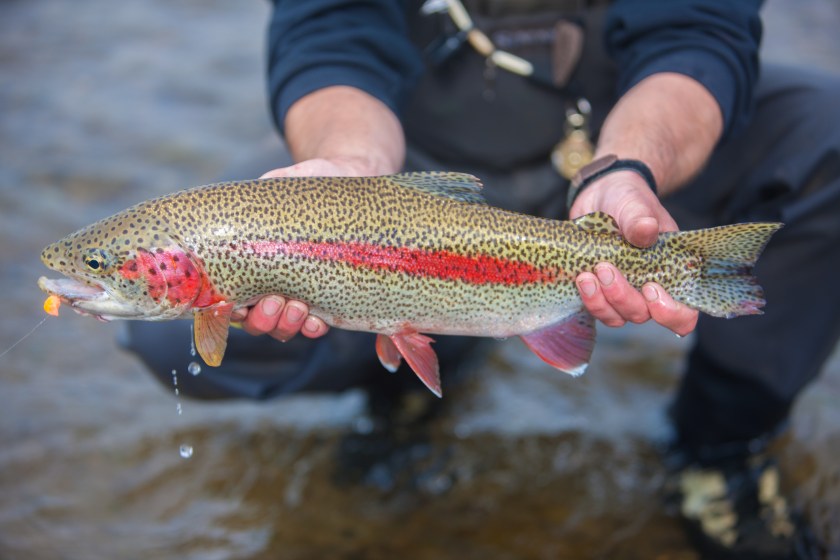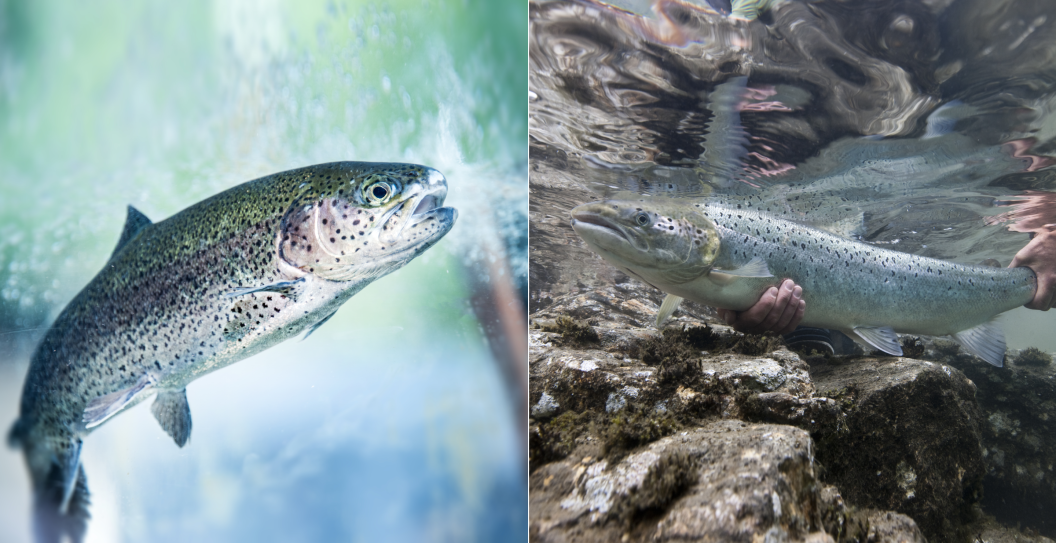For eons, fishermen have had trouble distinguishing steelhead trout versus salmon, and they are not alone. Large, aggressive, silver-toned, and smooth-scaled, both steelhead and salmon are members of the salmonids family; they look similar and feast on the same diet of smaller fish and krill. Both being anadromous fish, both salmon and steelhead live in fresh water and salt water, traveling between them to spawn.
Because of all these similarities, the fish have been misclassified by science throughout the years. At different times, the steelhead was considered a species of salmon although it is, in fact, a type of trout, with both belonging to the salmonidae family. Both species of fish are a favorite with anglers because they're fun to pursue and put up a good fight, putting them on the bucket list of many sport fishermen. Here's how to tell the difference between these similar-but-different species.
Steelhead Trout: The Basics

Getty Images, Cristina Nafzger
Steelhead (Oncorhynchus mykiss irideus) are a type of rainbow trout (Oncorhynchus mykiss)—not a type of salmon. More specifically, steelhead trout are the sea-run version of the freshwater rainbow trout. This means they spend the majority of their time in the ocean or other large brackish body of water before making their trip upstream to reproduce in fresh water.
A defining characteristic of steelhead is their size compared with typical, river-dwelling rainbow trout. Steelhead eat well in the ocean, which helps them outpace their river cousins in size. When they migrate to the ocean, steelhead lose the bright rainbow coloring they had in the river and become more silvery, similar to salmon in the ocean.
"Some [trout] stay in the freshwater all their lives and those are the rainbow trout," says Paul Grant of Canada's Department of Fisheries and Oceans. "The steelhead are the anadromous form that migrate into the ocean. They change color and get much, much larger than the resident rainbow trout."
Steelhead have long bodies, wide tails, short-set mouths, and varying coloration. Plain-Jane rainbow trout remain in fresh water throughout their lives, while steelhead live in salt water for part of their life, then move to freshwater rivers or lakes when they are ready to breed.
Steelhead spawn and grow to adults in gravel-bottomed, fast-flowing, well-oxygenated rivers and streams, then make their way to salt water. Of note: In the Eastern U.S., steelhead don't migrate to the ocean. There, the Great Lakes—Ontario, Erie, Superior, Michigan, and Huron—serve as their home base.
Here's another wrench to toss into the mix: The terminology used to refer to steelhead varies depending on where you are in the country. While East Coasters refer to lake-run rainbows as steelheads, West Coasters debate this with the simple question: What ocean to do they travel to? So is it then the migratory behavior that truly defines a steelhead, or is it where they migrate to? Does a rainbow trout need to bathe in salt water before it is christened with the term steelhead? All up for debate.
A few steelhead facts from NOAA (National Oceanic and Atmospheric Administration):
- Weight: up to 55 pounds
- Length: up to 45 inches
- Lifespan: up to 11 years
Salmon: The Basics

Getty Images, bbperry
There are multiple kinds of salmon in North America, including Chinook (king) salmon, coho, sockeye salmon, chum, Atlantic, and pink salmon. Most in the salmon family are native to the Pacific Ocean from Alaska down the California coast, except for the Atlantic salmon—which unsurprisingly, is native to the Atlantic waters off the East Coast from Canada on down. Chinook and coho salmon are found in strong numbers in the Great Lakes but aren't native; rather, they've been stocked there for decades to support a robust sport fishery.
Salmon generally have long, shiny, torpedo-shaped bodies with a big mouth and a wide-based tail. Coloration changes depending on whether they are in salt water or fresh water.
Along the Pacific coast, salmon are struggling and numbers are dwindling. This is due to multiple factors, including habitat destruction (such as human-made dams and other impediments), climate change, and more. But on the east side of the nation, salmon populations are thriving.
A few salmon facts from NOAA:
- Weight: From 40 pounds to 120 pounds
- Length: Up to 3 feet
- Lifespan: Up to seven years; typically three to four years
What Are the Differences: Steelhead Trout vs. Salmon?

Getty Images/Dave Alan
While steelhead and salmon have many shared physical characteristics, they have some key differences that set them apart from each other.
Steelhead vs. Salmon: Appearance
These two types of fish can look remarkably alike, especially while they're living in the ocean. Both have a very bright chrome or silver body with a dark or black-colored back.
Only steelhead may have a prominent red or pink stripe down their side. They share this characteristic with rainbow trout. But not all steelhead carry this definitive giveaway. Most do, but some don't, so a fish without a pink line isn't necessarily a trout.
Salmon typically grow bigger than steelhead. While steelhead generally top out around 20 pounds and near 20 to 25 inches as adults, salmon can grow twice that size.
One more way to differentiate between steelheads and some salmon is to glance into their mouths. Pacific salmon have dark or black gums, but steelheads have white gums. But here's the catch: Atlantic salmon also have white gums. So, if you're fishing in Atlantic salmon territory, this isn't a reliable differentiator.
Steelhead vs. Salmon: Spawning
Spawning is when a fish travels back to the place it was born to reproduce. For steelhead, that could mean traveling back from the ocean to the tributary rivers or streams that they came from; and for Great Lakes steelhead, that would mean migrating from the Great Lakes back into those streams of origin. Those places of origin are their spawning grounds.
Steelhead fish spawn early in the year, in the late winter or early spring time frame between January and April, depending on the river's level and water temperature. Salmon spawn in the fall, usually from September to December.
Steelhead eggs (roe) are orange in color, while salmon eggs can range from a pale-yellowish orange color to dark reddish-orange.
Steelhead vs. Salmon: Lifespan
Steelhead trout and salmon have different lifespans depending on a variety of factors including genetics, diet, and habitat; but, in general, steelhead tend to live longer than most salmon species.
A typical steelhead lifecycle spans four to six years, although some can live up to 11 years. Steelhead, like salmon, spend the first part of their life in fresh water before migrating to salt water, where they fully mature. After anywhere from one to four years there, steelhead return to fresh water to their spawning grounds. Sometimes, they die at the end of this process, but not necessarily.
The salmon life cycle is shorter than steelhead's life cycle. They also start their lives in freshwater, migrate to the salt water, spend time there, and then return to freshwater to spawn. For salmon, this process plays out more quickly, typically in two to seven years, and salmon usually die after spawning once.
How Do You Fish for Steelhead?

Photo by lightasafeather/ Getty Images
Steelhead fishing is a popular activity for anglers—and it's no wonder, as steelhead are a lot of fun to fish for. The approach varies depending on different waterway locations, conditions, time of year, and even time of day. Fishing for steelhead trout can be done in a variety of ways, including float fishing, plunking, fly fishing, bottom bouncing, lure fishing, and trolling.
Where the steelhead are located at the time—ocean or Great Lake versus river—determines the methods used to approach catching them. Float fishing is generally the most effective way to catch steelhead in a river, according to TroutandSteelhead.net. Float fishing steelhead involves suspending bait below a specialized float bobber and allowing the bait and bobber to drift naturally down the river with the current. There are many different float fishing rigs, but three popular ones are a fixed float rig, a slip float rig, and a bobber doggin rig. The idea here is to allow the bait to drift down the current and attract a bite from a hungry steelhead.
Plunking is a lot like how it sounds. It's basically just plunking your bait into a spot that looks as if it might hold steelhead and keeping the bait there, as opposed to drifting it down the current. A little extra weight might be useful on this setup to hold the bait in place than with drift fishing.
Another tried-and-true method for fishing steelhead is to throw out spinners or spoons with a spin casting rod. Colors and finishes can be tweaked depending on water conditions.
How Do You Fish for Salmon?

Photo By Bill Schaefer/Getty Images
Many of the same techniques that work well for steelhead fishing transfer over well to salmon fishing, too; and just like with steelhead, the methods used depend on a variety of factors including location, season, conditions, and so on.
River fishing methods include—but are not limited to—float and drift fishing, plunking, bottom bouncing, and spin casting. In an ocean or lake, trolling for salmon is a popular and proven method.
Trolling involves pulling a weighted line and a weighted tackle alongside and/or behind a boat at various depths to target salmon. Sometimes live bait is used, and sometimes lures and spinners are used. It all depends on what the salmon are hitting that day.
Salmon are tough fighters and give anglers a thrill to catch.
Is Steelhead Better for You Than Salmon?
The nutrition profiles of salmon versus steelhead are similar as well. Both fish, especially when caught wild, offer an array of nutrients and health benefits. To label either salmon or steelhead as healthier than the other would be like comparing apples to oranges.
A study from Food Struct put salmon and steelhead head-to-head in the nutritional value battle.
A single serving of steelhead contains vitamin B-12, omega-3 fatty acids, selenium, protein, and over 100 percent of the daily value of recommended vitamin D.
Salmon offers vitamins B3, B5, B6, B12, D, and E, selenium, potassium, omega 3-fatty acids, and protein. It has a higher fat content than steelhead. Salmon is richer in monounsaturated fats, polyunsaturated fats, vitamins, and folate. It is also lower in sodium than steelhead.
In comparison, steelhead trout is richer in vitamin B12 and is lower in calories and lower in saturated fat.
From a health benefits perspective, regular consumption of salmon has been linked to a decrease in triglycerides, LDL "bad" cholesterol, and blood pressure. Both steelhead trout and salmon are low in carbohydrates, making them an ideal choice for people looking to reduce their carb intake. They are also both low in calories and fat overall, which makes them a good option for weight management.
Does Steelhead Taste the Same as Salmon?

Photo by allie12/Getty Images
While similar, both types of fish have their own unique flavor profile that vary slightly depending on the fishes' diet and where they were caught. Steelhead have a generally milder flavor, while salmon tend to be bolder, fattier, and more "fishy." This applies even to farm-raised fish.
Steelhead and salmon both have pinkish-orange flesh, although steelhead's flesh can often be slightly lighter in color than a salmon's typical bright red-orange coloration.
The flesh color depends largely on what the fish eat, according to Alaska Salmon Company. Wild salmon tend to have a darker, richer color than farmed salmon, due to their diet, which is largely made up of carotenoid-rich algae, krill, and other small organisms.
Both fish fillets reach a tender and flaky texture when properly prepared. While steelhead is leaner than salmon, any differences in texture are fairly unnoticeable after cooking. Both can be used in a variety of recipes and cooking methods such as grilling, smoking, and baking, and both fillets tend to absorb whatever flavors they are cooked in.
READ MORE: Sailfish vs. Swordfish: The Main Differences Between the Species




